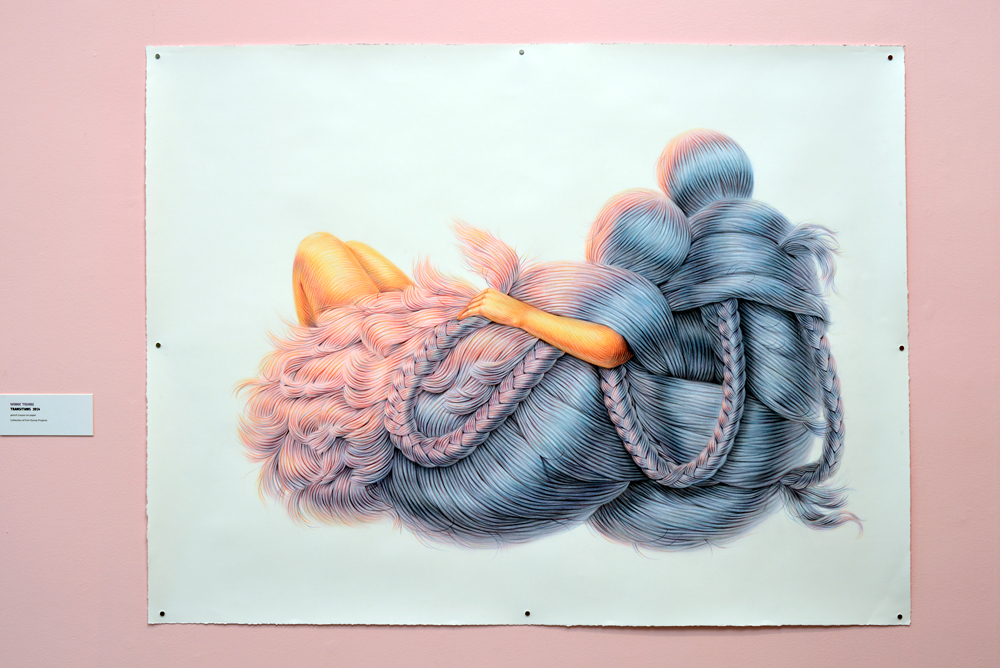In the documentary The Punk Singer, riot-grrrl icon Kathleen Hanna describes her fascination with girls making art in their bedrooms: “You can make whatever you want when you’re alone in your room,” she explains. “There are all these different girls’ bedrooms and all these girls are making their stuff, and then they’re throwing it away…how can we connect these bedrooms?” Today, the Internet connects these bedrooms. Young feminists are active online, posting selfies on Instagram, curating content on Tumblr, hashtagging their status updates (#YesAllWomen), “following” Beyonce and generating blogs. Yet the Internet’s open frontier has proven a hostile environment for those who speak out about gender issues. If anonymous, networked, virtual spaces seem unsafe for feminist positions—or at least ineffective—why not move to the embodied realm of the material?
“Material Girls” at the Dunlop Art Gallery took up this challenge and foregrounded materiality, staking playful new ground in the discourse of contemporary feminist art. Curated by Jennifer Matotek, Blair Fornwald and Wendy Peart, “Material Girls” featured work by 24 women artists from Canada and abroad working in practices ranging from new media to craft. These artists transformed the gallery from its usual white cube into something unapologetically colourful and productively cacophonous, striking a balance between clean conceptual sophistication and the messiness of a teenage girl’s bedroom.
Throughout history, women have traditionally been relegated to the realm of “base matter”—the formless and irrational, in opposition to the transcendental realm of the male. Elevating tactility, externality and the physical over the immaterial and conceptual, “Material Girls” reclaimed the once degraded “base matter” and shamelessly took up space in the gallery. Even the pastel wall paint and the patterned wallpaper, created by artist Alex Cu Unjieng to cordon off the “explicit content” in the centre of the gallery, contributed to this overabundance.
Feminine excess meets its most natural expression in craft. Historically, the devaluation of craft effectively marginalized the work of women, as practices ranging from crochet to beadwork were seen as utilitarian and feminine tasks with little merit. Katherine Boyer’s mixed-media work translates Google screenshot views into beadwork panels of the prairies. There is an evocative juxtaposition in Boyer’s use of decorative floral beadwork and a rocking chair—summoning intergenerational images of mothers, grandmothers and newborns—with the more masculine camouflage-like appearance of the beaded landscape panels. This coexistence of floral and geometric styles has a charged colonial history rooted in the fur trade, and Boyer grounds her contemporary beading practice within the history of traditional Indigenous practices and the agency of Indigenous women in craft. Taking a more Duchampian approach to craft, Allyson Mitchell’s Fifty Shades consists of two crocheted floral potholders and a pink macrame pouch positioned to suggest two breasts and a bush—crass signifiers of the female body. The textures bring to mind the domesticity of settler grandmothers in the prairies, while the fur lining on the macramé pouch elicits a campy humour. By including contemporary feminist crafting practices in this show, we are encouraged to consider the politics of “craft” in relation to more radical notions of excess, transgression and play.
This maximalist approach also seeped into the representations of the female figure throughout the show—bodies throughout the gallery appeared cloaked, abstracted and self-effacing. Winnie Truong, Raphaëlle de Groot, Rachel Ludlow, Dominique Rey and Meryl McMaster obstruct and efface the female figure to varying degrees: McMaster’s gaze meets the viewer through a large wire sculpture that she wears; de Groot dons a garish tactile sculpture on her head which fully covers her face and transforms her into something other-than-human as she walks through the streets of Venice; Truong’s surrealist figures are shrouded in pastel hair, intricately braided and curled around the figures’ heads; Ludlow’s disembodied objects of adornment serve as metonymies of femininity that effectively replace the female figure altogether. Even the nude figures in the explicit section were “masked”: Deirdre Logue’s three-channel video Velvet Crease features close-up footage of vulvas on display, doused in gold glitter and external light; Sarah Anne Johnson’s chromogenic nudes are subtly concealed through the figures’ gestures and Johnson’s use of paint, while the gaze of each figure is reverted away from the viewer. By incorporating fashion and adornment into feminist art, these works complicate the anti-capitalist thrust that characterized much third-wave feminist work; for example, Kathy Acker and Karen Finley’s use of shock and obscenity to critique the commodification of (female) bodies under capitalism. The works in “Material Girls” suggest that we are always already implicated in a capitalist system as consumers, and that interacting with matter to produce something self-consciously material is an act to be celebrated. Rather than upholding anti-materialist ideals, these artists relish consumption to varying degrees, resisting transparently political positions.
“Material Girls” paid as much, if not more, attention to the beautiful and consumable as it did to the grotesque. It shirked the third-wave feminist tendency to position bodies in relation to the abject as a counter to socially sanctioned norms of desirability and propriety. This approach—an emphasis on a less offensive materiality—can fruitfully open up the definition of a future feminism. If feminism is about choice, freedom of expression and inclusivity, then “Material Girls” succeeded in allowing women artists to respond to gendered issues through their own material practices; that some of these points of view rubbed up against others can only make the ensuing dialogue more nuanced.









